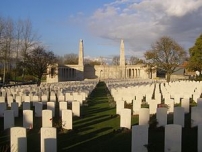| First Name: | George | Last Name: | ANGUS | |
|---|---|---|---|---|
| Date of Death: | 09/08/1918 | Lived/Born In: | Edmonton | |
| Rank: | Sergeant | Unit: | London7 | |
| Memorial Site: | Vis-en-Artois Memorial, France | |||
Current Information:Age-22 90, Bulwer Road, Upper Edmonton
After having been on the defensive since March 1918, by August of that year the Allies were ready to move to the attack and on 8th August, The Battle of Amiensbegan, a battle that marked the beginning of what came to be known as the Hundred Day Offensive that culminated in the collapse of the German army and the end of the war. British, Australian and Canadian troops attacked on a wide front that stretched about eighteen miles from Morlancourt, north of the River Somme to the Amiens-Roye road while the French launched their own offensive to the south in the Battle of Montdidier. At 4.20am on 8th August, aided by early morning mist and backed by 900 guns, 600 tanks and 2000 aircraft the assault was unleashed on the unsuspecting Germans many of whom surrendered straight away. Their resistance stiffened as the day progressed but despite this the Allied forces advanced about 7 miles by nightfall and further, but far less spectacular, gains were made over the next three days until the battle ended on 11th August. Losses had been enormous on both sides. British, Australian and Canadian casualties amounted to 19,000 but the Germans lost 26,000, including 12,000 taken prisoner, an awful blow that prompted Ludendorff, the German supremo, to call it the ‘Black Day’ of the German Army. III Corps, north of the Somme had the task of protecting the flank of the Australians, keeping pace with their advance and securing the high ground overlooking the passages of the Somme. They attacked from right to left with 58th, 18th and 12th Divisionsbut despite having a more modest role than the Australians and Canadians they were unable to achieve the same measure of progress as them and on the opening day of the battle only managed to reach their first objective. This was due to the difficulty of the ground over which they attacked and the fact that they had all been heavily involved in the earlier battles of 1918 which meant that not only was there a shortage of officers and NCOs but that their ranks were filled with young, inexperienced recruits. To add to their problems, on the night of 7/8th August, before the attack began, this area, north of the Somme was subjected to heavy enemy shelling, including many gas shells, which not only caused casualties but hindered their progress to their starting lines as well. 174 Brigade of 58th Division used the 6th London and 7th London battalions for their attack on Malard Wood, with 8th London in reserve. On this section of the front the enemy was aware that something was happening and their artillery and machine-guns were still active when the attack went in at 4.20am. However a strong and effective creeping artillery barrage soon dealt with the German guns and the men of 174 Brigade moved forward close behind the barrage in small groups at wide intervals, followed by larger parties. With the only resistance coming from machine-gun fire they soon captured the enemy front line. The advance to Malard Wood was decidedly tougher especially for 6th London who had to fight all the way, but by 8am a line was established on the far side of the wood. At this stage 173 Brigade moved up to continue the attack towards Chipilly Ridge but in the face of concentrated machine-gun fire were unable to make any progress. At 4.15pm on the following day, 9th August, the attack was resumed and at 5.30pm 7th London joined in the attack and headed for the south-eastern corner of Gressaire Wood. There followed a long, hard struggle but eventually both the wood and Chipilly were captured. 7th London went into action with 17 officers and 360 other ranks and ended the day with just 3 officers and 60 men. One of their casualties was George Angus. |
||||
| « Back to Search Results | ||||
| If you think any of the information shown here is incorrect, Click Here to submit your amends and comments | ||||




